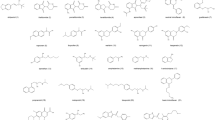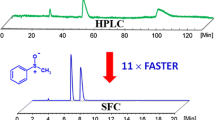Abstract
Dipeptides are stereo-specifically involved in several biological functions that are challenging to separate enantiomerically. Elution order of enantiomers is an important issue in chiral chromatography. Amylose tris-(3,5-dimethylphenylcarbamate) chiral stationary phase (CSP) is the best and most-widely-used CSP in chiral separations, but experimental data of enantiomeric separation of dipeptides on this CSP is lacking. Simulation studies were conducted to determine the order of elution and the chiral recognition mechanism of didpetides on this CSP. Results indicated that the docking energy of SR-enantiomers were higher than SS-antipodes. The range of docking energies for SR-enantiomers was −7.44 to −5.92 kcal/mol with CSP, but −7.15 to −5.87 kcal/mol for SS-stereoisomers. Therefore it is predicted that SS-enantiomer will elute first, followed by SR-antipode. Furthermore, hydrogen bondings, van der Waal’s interactions and electrostatic interactions were observed among SR- and SS-enantiomers and chiral grooves of CSP. The number of hydrogen bonds was one in each enantiomer binding except S-Ala-R-Tyr, which contained two hydrogen bonds. No hydrogen bond was found in S-Ala-R-Trp, S-Leu-S-Trp, and S-Leu-S-Tyr dipeptides bindings. The chiral recognition mechanisms dictate different strengths of stereoselective bindings of the enantiomers on CSP.
Similar content being viewed by others
References
Humphrey MJ, Ringrose PS. Peptides and related drugs: a review of their absorption, metabolism, and excretion. Drug Metabolism Rev, 1986, 17: 283–310
Prasad C. Bioactive cyclic dipeptides. Peptides, 1995, 16: 151–164
Yagasaki M, Hashimoto S. Synthesis and application of dipeptides: current status and perspectives. Appl Microbiol Biotech, 2008, 81: 13–22
Soga T, Sugimoto M, Honma M. Mori M, Igarashi K, Kashikura K, Ikeda S, Hirayama A, Yamamoto T, Yoshida H, Otsuka M, Tsuji S, Yatomi Y, Sakuragawa T, Watanabe H, Nihei K, Saito T, Kawata S, Suzuki H, Tomita M, Suematsu M. Serum metabolomics reveals γ-glutamyl dipeptides as biomarkers for discrimination among different forms of liver disease. J Hepatol, 2011, 55: 896–905
Czerwenka C, Lindner W. Stereoselective peptide analysis. Anal Bioanal Chem, 2005, 382: 599–638
Schmid MG. Chiral metal-ion complexes for enantioseparation by capillary electrophoresis and capillary electrochromatography: a selective review. J Chromatogr A, 2012, 1267: 10–16
Scriba GKE. Recent advances in enantioseparations of peptides by capillary electrophoresis. Electrophoresis, 2003, 24: 4063–4077
Soukup-Hein RJ, Schneiderheinze J, Mehelic P, Armstrong DW. LC and LC-MS separation of peptides on macrocyclic gly copeptide stationary phases: diastereomeric series and large peptides. Chromatographia, 2007, 66: 461–468
Kašička V. Recent developments in CE and CEC of peptides (2009-2011). Electrophoresis, 2012, 33: 48–73
Fornstedt T, Sajonz P, Guiochon G. A closer study of chiral retention mechanisms. Chirality, 1998, 10: 375–381
Asnin L. Adsorption models in chiral chromatography. J Chromatogr A, 2012, 1269: 3–25
Francotte ER. Enantioselective chromatography as a powerful alternative for the preparation of drug enantiomers. J Chromatogr A, 2001, 906: 379–397
Zhang T, Kientzy C, Franco P, Ohnishi A, Kagamihara Y, Kurosawa H. Solvent versatility of immobilized 3,5-dimethylphenylcarbamate of amylose in enantiomeric separations by HPLC. J Chromatogr A, 2005, 1075: 65–75
Yashima E, Yamamoto C, Okamoto Y. Enantioseparation on fluoro-methylphenylcarbamates of cellulose and amylose as chiral stationary phases for high-performance liquid chromatography. Polymer J, 1995, 27: 856–861
Tang Y, Reepmeyer JC, Revelle LK, Wilson JA. Enantioseparation of 3-phenylacetylamino-2,6-piperidinedione and related chiral compounds. J Chromatogr A, 1996, 752: 93–99
Yashima E, Sahavattanapog P, Okamoto Y. HPLC enantioseparation on cellulose tris(3,5-dimethylphenylcarbamate) as a chiral stationary phase: influences of pore size of silica gel, coating amount, coating solvent, and column temperature on chiral discrimination. Chirality, 1996, 8: 446–451
Chankvetadze B, Yashima E, Okamoto Y. Dimethyl-, dichloro- and chloromethylphenyl carbamates of amylose as chiral stationary phases for high-performance liquid chromatography. J Chromatogr A, 1995, 694: 101–109
Yashima E, Kasashima E, Okamoto Y. Enantioseparation on 4-halogen-substituted phenylcarbamates of amylose as chiral stationary phases for high-performance liquid chromatography. Chirality, 1997, 9: 63–68
Cass QB, Tiritan ME, Calafatti SA, Matlin SA. Enantioseparation on amylose tris (3, 5-dimethoxyphenyl carbamate): application to commercial pharmaceutical chiral drugs. J Liq Chromatogr & Related Technol, 1999, 22: 3091–3099
Wu SH, Lin SL, Lai SY, Chou TH. Separation of enatiomeric protected dipeptides by chiral high-performance liquid chromatography. J Chromatogr A, 1990, 514: 325–329
Lin SL, Chen ST, Wu SH, Wang KT. Separation of aspartame and its precursor stereoisomers by chiral chromatography. J Chromatogr A, 1991, 540: 392–396
Aboul-Enein HY, Ali I. Studies on the effect of alcohols on the chiral discrimination mechanisms of amylose stationary phase on the enantioseparation of nebivolol by HPLC. J Biochem Biophys Meth, 2001, 48: 175–188
Ali I, Al-Othman ZA, Al-Warthan A, Alam SD, Farooqi JA. Enantiomeric separation and simulation studies of pheniramine, oxybutynin, cetirizine, and brinzolamide chiral drugs on amylose-based columns. Chirality, 2014, 26: 136–143
Sanner MF. Python: a programming language for software integration and development. J Mol Graph Mod, 1999, 17: 57–61
Pettersen EF, Goddard TD, Huang CC, Couch GS, Greenblatt DM, Meng EC, Ferrin TE. UCSF Chimera — a visualization system for exploratory research and analysis. J Comp Chem, 2004, 25: 1605–1612
Accelrys Software Inc., Discovery Studio Modeling Environment, Release 3.5. San Diego: Accelrys Software Inc., 2012
Gübitz G, Schmid MG. Chiral Separation Methods and Protocols Series: Methods in Molecular Biology. New York: Humana Press, 2004
Ali I, Lahoucine N, Ashraf G, Aboul-Enein HY. Chiral separations of piperidine-2,6-dione analogues on Chiralpak IA and Chiralpak IB columns by using HPLC. Talanta, 2006, 69: 1013–1017
Author information
Authors and Affiliations
Corresponding author
Rights and permissions
About this article
Cite this article
Ali, I., Haque, A., Al-Othman, Z.A. et al. Stereoselective interactions of chiral dipeptides on amylose based chiral stationary phases. Sci. China Chem. 58, 519–525 (2015). https://doi.org/10.1007/s11426-014-5239-z
Received:
Accepted:
Published:
Issue Date:
DOI: https://doi.org/10.1007/s11426-014-5239-z




